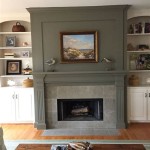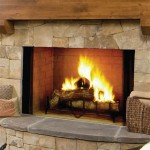Choosing the Right Paint for Your Fireplace
A fireplace serves as a focal point in many homes, offering both warmth and aesthetic appeal. Over time, however, the appearance of a fireplace can diminish due to soot, heat, and general wear and tear. Painting a fireplace is a cost-effective way to rejuvenate its look and integrate it seamlessly with the interior design of a room. However, selecting the appropriate paint for a fireplace requires careful consideration of several factors, including the material of the fireplace, the level of heat exposure, and the desired aesthetic outcome. Using the wrong type of paint can lead to peeling, cracking, discoloration, and potentially even fire hazards. Therefore, a thorough understanding of paint types and preparation techniques is essential.
The process of painting a fireplace involves several distinct stages, beginning with surface preparation, moving through the application of primer, and concluding with the application of the topcoat. Each stage demands specific materials and techniques to ensure a durable and visually appealing finish. Neglecting any of these stages can compromise the longevity and appearance of the paint job. Moreover, safety precautions must be observed throughout the process, particularly when dealing with heat-resistant paints that may contain volatile organic compounds (VOCs).
Key Considerations Before Painting a Fireplace
Before commencing any painting project on a fireplace, a comprehensive assessment of the fireplace's condition and material composition is paramount. Understanding these aspects enables informed decisions regarding the appropriate paint type and preparation methods. Ignoring these initial steps can lead to unsatisfactory results and necessitate costly repairs later on.
First, identify the material of the fireplace surround. Common materials include brick, stone, concrete, marble, and wood. Each material possesses unique properties that influence paint adhesion and heat resistance requirements. For instance, brick and stone are porous and require paints that can penetrate and bond effectively with the surface. Wood, on the other hand, necessitates paints that flex with temperature changes to prevent cracking. Marble, being a delicate material, may require specialized paints designed to avoid staining or damage.
Secondly, assess the level of heat exposure the fireplace surround experiences. The area directly around the firebox is subjected to the most intense heat, while the upper portions of the surround experience less. This variation in heat exposure dictates the type of paint required for different sections of the fireplace. High-heat paints formulated for stoves and grills are essential for areas closest to the firebox. These paints are designed to withstand temperatures exceeding 1200°F. For areas further away from the firebox, standard heat-resistant paints may suffice, provided they are rated for the expected temperature.
Third, consider the desired aesthetic outcome. The choice of paint color and finish should complement the overall decor of the room. Lighter colors can brighten a room and make the fireplace appear larger, while darker colors can create a dramatic and cozy atmosphere. Matte finishes tend to conceal imperfections, while glossy finishes offer a more modern and reflective look. It is also important to consider the existing architectural style of the house when selecting a paint color and finish.
Selecting the Right Type of Paint
Choosing the right type of paint is critical for a successful and long-lasting fireplace makeover. The selection process should be guided by the fireplace material and the level of heat exposure. Incorrect paint selection can result in peeling, blistering, cracking, and discoloration, ultimately undermining the aesthetic and structural integrity of the fireplace.
For brick and stone fireplaces, masonry paints are generally recommended. These paints are specifically formulated to adhere to porous surfaces and withstand the alkaline environment of masonry. Latex masonry paints are water-based and offer good breathability, allowing moisture to escape from the brick or stone. This is important because trapped moisture can cause paint to peel or crack. Acrylic masonry paints are more durable and offer better resistance to fading and cracking, making them a good choice for fireplaces that are exposed to direct sunlight or frequent use. Both latex and acrylic masonry paints are available in a variety of colors and finishes.
For areas directly around the firebox, high-heat paints are essential. These paints are typically formulated with a silicone or ceramic base and are designed to withstand temperatures ranging from 500°F to 1200°F. High-heat paints are available in aerosol cans or quarts and are typically applied in thin, even coats. It is crucial to follow the manufacturer's instructions carefully when applying high-heat paint, as improper application can lead to bubbling or peeling. These paints are often available in a limited range of colors, typically black, gray, and brown, due to the pigments required for high-temperature resistance.
For wooden fireplace mantels and surrounds, latex or acrylic paints are suitable, provided they are formulated for interior use. These paints offer good adhesion, durability, and a wide range of color options. Primer is essential when painting wood, as it seals the surface and provides a uniform base for the topcoat. Choose a primer specifically designed for wood surfaces to ensure optimal adhesion. Consider using a paint with a satin or semi-gloss finish, as these finishes are easier to clean and more resistant to scuffs and scratches. Oil-based paints are not recommended for wooden mantels due to their tendency to yellow over time and their higher VOC content.
Preparation and Application Techniques
Proper preparation and application techniques are essential for achieving a professional-looking and durable paint job on a fireplace. Thorough preparation ensures that the paint adheres properly to the surface, while careful application minimizes imperfections and maximizes the longevity of the finish. Rushing these steps can lead to unsatisfactory results and necessitate costly rework.
Begin by thoroughly cleaning the fireplace surround. Use a wire brush to remove loose mortar, soot, and debris. For brick and stone fireplaces, a pressure washer can be used to remove stubborn stains and dirt. However, exercise caution when using a pressure washer on delicate materials such as marble, as excessive pressure can cause damage. For wooden mantels, use a mild detergent and water to clean the surface, followed by a thorough rinsing and drying. Ensure the surface is completely dry before proceeding to the next step.
Next, repair any cracks or damage to the fireplace surround. Use a masonry repair compound to fill cracks in brick or stone. For wooden mantels, use wood filler to repair dents and scratches. Allow the repair compound or wood filler to dry completely before sanding the surface smooth. Sanding creates a uniform surface for the primer to adhere to. Use fine-grit sandpaper to avoid scratching the surface. Vacuum the area thoroughly to remove any sanding dust.
Apply a primer appropriate for the fireplace material. For brick and stone fireplaces, use a masonry primer. For wooden mantels, use a wood primer. Apply the primer in thin, even coats using a brush or roller. Allow the primer to dry completely according to the manufacturer's instructions. Primer is crucial as it seals the surface, promotes adhesion of the topcoat, and helps to prevent stains from bleeding through the paint.
Finally, apply the topcoat paint. Use a brush, roller, or sprayer to apply the paint in thin, even coats. For areas around the firebox, use a high-heat paint specifically designed for that purpose. Allow each coat of paint to dry completely before applying the next coat. Two coats of paint are typically sufficient for achieving full coverage and a durable finish. Follow the manufacturer's recommendations regarding drying times and application techniques. Proper ventilation is crucial when applying paint, especially paints with high VOC content. Ensure adequate airflow by opening windows and using a fan.
Following these guidelines will help ensure a successful fireplace painting project, enhancing the beauty and longevity of this important architectural feature.

How To Paint A Brick Fireplace Sarah Joy

How To Paint A Fireplace Surround 3 Colour Ideas Boo Maddie

How To Paint A Fireplace Interior Design Diy Tips Direct Fireplaces

How To Paint A Fireplace Graham Brown

How To Paint Your Fireplace White And Is It Worth Bev Cooks

How To Paint A Brick Fireplace Young House Love

How To Paint A Brick Fireplace Sarah Joy

A Fireplace Surround Transformation Guide Inspired By My Smurf Blue Makeover Architectural Digest

Stonelux Fireplace Paint Stone Coating Effect

How To Paint A Brick Fireplace What Use Home With Janny
Related Posts








